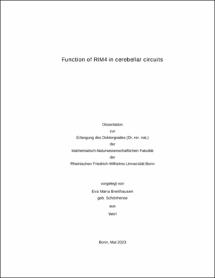Breithausen, Eva Maria: Function of RIM4 in cerebellar circuits. - Bonn, 2023. - Dissertation, Rheinische Friedrich-Wilhelms-Universität Bonn.
Online-Ausgabe in bonndoc: https://nbn-resolving.org/urn:nbn:de:hbz:5-73400
Online-Ausgabe in bonndoc: https://nbn-resolving.org/urn:nbn:de:hbz:5-73400
@phdthesis{handle:20.500.11811/11193,
urn: https://nbn-resolving.org/urn:nbn:de:hbz:5-73400,
author = {{Eva Maria Breithausen}},
title = {Function of RIM4 in cerebellar circuits},
school = {Rheinische Friedrich-Wilhelms-Universität Bonn},
year = 2023,
month = dec,
note = {RIMs (Rab3-interacting molecules) are multidomain proteins, enriched at presynaptic active zones. The large isoforms (RIM1 a/ß, RIM2 a/ß) have been shown to be important for mediating presynaptic active zone function by coupling synaptic vesicles to voltage-gated calcium channels and by regulating neurotransmitter release as well as presynaptic plasticity. The functional role of the small RIM isoforms, RIM3 and RIM4, in particular in vivo has so far remained unresolved. Previous studies showed that constitutive RIM4 knock-out (KO) mice developed spontaneous episodes of strong hind limb impairments with rapid movements accompanied by weight loss after weaning, whereas constitutive RIM3 KO mice did not exhibit obvious motor impairments.
Since movement generation and execution is mainly processed in cerebellar structures, we focused in this study on the potential functions of RIM4 in cerebellar circuits. Using mice expressing lacZ under the endogenous RIM4- or RIM3-promotor, we show that RIM4 as well as RIM3 are non-uniformly distributed on a cellular level in the mouse brain. Highest RIM4 expression was observed in the cerebellum and highest RIM3 expression was observed in the thalamus. Furthermore, experiments in primary neuronal cultures unveiled that Rims4 gene expression was regulated by increased neuronal activity. In addition, we showed in this study that the deletion of RIM4 did not alter the cerebellar and cortical transcriptome and proteome of constitutive RIM4 KO mice.
In order to examine if the observed motor impairments of constitutive RIM4 KO mice resulted from a dysfunction in the cerebellum, we generated Pcp2Mpin-Cretg:RIM4fl/fl mice, in which Cre recombination is mainly restricted to cerebellar Purkinje cells. These mice develop episodically occurring motor impairments similar to constitutive RIM4 KO mice. To further characterize this mouse line and the occurrence of the episodic motor impairments, in vivo single unit recordings in freely moving Pcp2Mpin-Cretg:RIM4fl/fl mice were performed. These recordings unveiled no alterations in cerebellar firing frequency under baseline conditions. However, the cerebellar firing frequency was reduced during the motor episodes of the Pcp2Mpin-Cretg:RIM4fl/fl mice, induced by a single injection of caffeine. Taken together, we propose that RIM4 in Purkinje cells is required to maintain normal electrophysiological properties of the cerebellar network and in turn, RIM4 deficiency results in a phenotype resembling human ataxias and dyskinesias.},
url = {https://hdl.handle.net/20.500.11811/11193}
}
urn: https://nbn-resolving.org/urn:nbn:de:hbz:5-73400,
author = {{Eva Maria Breithausen}},
title = {Function of RIM4 in cerebellar circuits},
school = {Rheinische Friedrich-Wilhelms-Universität Bonn},
year = 2023,
month = dec,
note = {RIMs (Rab3-interacting molecules) are multidomain proteins, enriched at presynaptic active zones. The large isoforms (RIM1 a/ß, RIM2 a/ß) have been shown to be important for mediating presynaptic active zone function by coupling synaptic vesicles to voltage-gated calcium channels and by regulating neurotransmitter release as well as presynaptic plasticity. The functional role of the small RIM isoforms, RIM3 and RIM4, in particular in vivo has so far remained unresolved. Previous studies showed that constitutive RIM4 knock-out (KO) mice developed spontaneous episodes of strong hind limb impairments with rapid movements accompanied by weight loss after weaning, whereas constitutive RIM3 KO mice did not exhibit obvious motor impairments.
Since movement generation and execution is mainly processed in cerebellar structures, we focused in this study on the potential functions of RIM4 in cerebellar circuits. Using mice expressing lacZ under the endogenous RIM4- or RIM3-promotor, we show that RIM4 as well as RIM3 are non-uniformly distributed on a cellular level in the mouse brain. Highest RIM4 expression was observed in the cerebellum and highest RIM3 expression was observed in the thalamus. Furthermore, experiments in primary neuronal cultures unveiled that Rims4 gene expression was regulated by increased neuronal activity. In addition, we showed in this study that the deletion of RIM4 did not alter the cerebellar and cortical transcriptome and proteome of constitutive RIM4 KO mice.
In order to examine if the observed motor impairments of constitutive RIM4 KO mice resulted from a dysfunction in the cerebellum, we generated Pcp2Mpin-Cretg:RIM4fl/fl mice, in which Cre recombination is mainly restricted to cerebellar Purkinje cells. These mice develop episodically occurring motor impairments similar to constitutive RIM4 KO mice. To further characterize this mouse line and the occurrence of the episodic motor impairments, in vivo single unit recordings in freely moving Pcp2Mpin-Cretg:RIM4fl/fl mice were performed. These recordings unveiled no alterations in cerebellar firing frequency under baseline conditions. However, the cerebellar firing frequency was reduced during the motor episodes of the Pcp2Mpin-Cretg:RIM4fl/fl mice, induced by a single injection of caffeine. Taken together, we propose that RIM4 in Purkinje cells is required to maintain normal electrophysiological properties of the cerebellar network and in turn, RIM4 deficiency results in a phenotype resembling human ataxias and dyskinesias.},
url = {https://hdl.handle.net/20.500.11811/11193}
}






